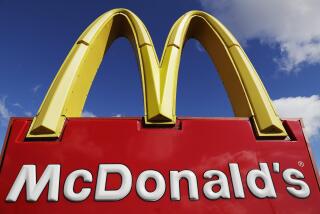Pass the Food and More Information About What’s in It
- Share via
This column, one of our occasional examinations of new products and services, is heavy on food goods. But that’s fitting for a population that can afford to pick and choose among myriad ways to take its nutrition.
First, some finance. Banks want to serve more low-income customers--a concern that coincidentally keeps coming up in the congressional banking reform bills. According to the American Bankers Assn., 61% of commercial banks are courting these customers this year, up from 44% in 1985.
This seems odd, since such customers have little money and “limited banking needs.” But then, banks are offering them only limited banking services--8 to 10 checks processed free a month--in return for low minimum balances and fees.
The implication is that banks--”virtually alone among all financial services providers,” says the ABA--are doing this as a public service, and at some cost. “Approximately 40% of banks reported,” says the ABA, “that their basic banking accounts incurred a loss or just broke even.”
Doesn’t this leave some 60% that are profitable? Well, maybe half of them, says the ABA; the rest aren’t sure. Listen, not everyone has a head for figures. They’re bankers, not accountants.
With less fanfare than other fast-food chains, Hardee’s restaurants in Washington and Baltimore have converted to recycled plastic hamburger clamshells. According to the trade magazine Plastics & You, Hardee’s new containers are 50% “post-consumer” material, sandwiched between layers of “virgin polystyrene,” and the original consumers were schoolchildren at 480 schools in the Los Angeles Unified School District.
We’re onto something here--advertising the source of recycled materials. All recycled polystyrene is shredded, washed and melted down for reconstituting, but wouldn’t you rather eat off “post-consumer” materials from little kids’ lunch trays than from sweepings at the L.A. Zoo, say, or New York’s Port Authority bus terminal?
New York City’s Consumer Affairs Department wants fast-food restaurants there to provide nutritional breakdowns for menu items--something that many already do, if not to the degree proposed. If the proposal passes and the idea spreads beyond New York, the fifth of the population who eat fast food every day will get more than their daily ration of greasy kid stuff. They’ll get posters and tray liners stating recommended daily allowances of calories, fat and sodium, and listing sample breakfasts, lunches and dinners ranging from least fatty to most fatty. Brochures will analyze all menu items, and menus will urge customers to read everything.
Some people may believe that this goes too far. They want to enjoy poor nutrition in peace, without being lectured by wall hangings, menus and place mats.
I say it doesn’t go far enough. Wrap each item in information: “Chicken strips, our lowest calorie item,” or “This salad dressing contains as much fat as two hamburgers.” And extend the law to fancy restaurants, so buying chateaubriand with Bearnaise sauce (2,400 calories, 120 grams of fat) provides no escape.
This health stuff’s not easy. Take Pepperidge Farm’s new line of fat-free poundcakes, one of many new products slathered with promises of low calories, no fat, freedom from cholesterol.
It can be confusing. A cake billed as “1/3 less calories” than “typical” poundcake is still two-thirds the calories--at 70 versus 105 calories no great cut. “No artificial flavors” seems straight-forward, but who knows what constitutes “natural cream flavor,” “natural butter flavor” and “natural coconut flavor?” It’s clearly not pure butter, cream or coconut, but even Pepperidge Farm refers inquiries to the flavor supplier and the FDA.
Pepperidge Farm even gives us a Fat Wheel to calculate the percentage of calories consumed from fat (30% is the recommended daily limit). We have to match a food’s total calories on one wheel with its total fat grams on another, reading the percentage in a little window. We can then calculate ideal daily totals of both, divide our body weight by the date and, subtracting the number of letters in our mother’s maiden name, come up with our income.
Can’t anyone just get something to eat around here?
More to Read
Eat your way across L.A.
Get our weekly Tasting Notes newsletter for reviews, news and more.
You may occasionally receive promotional content from the Los Angeles Times.










